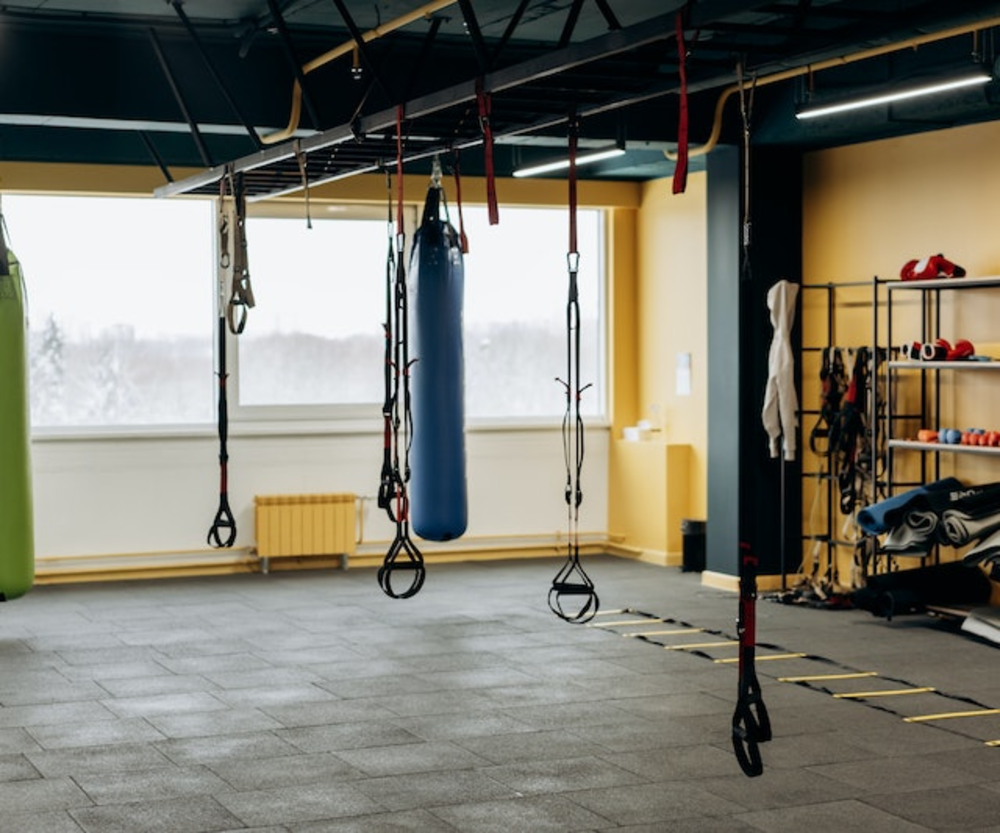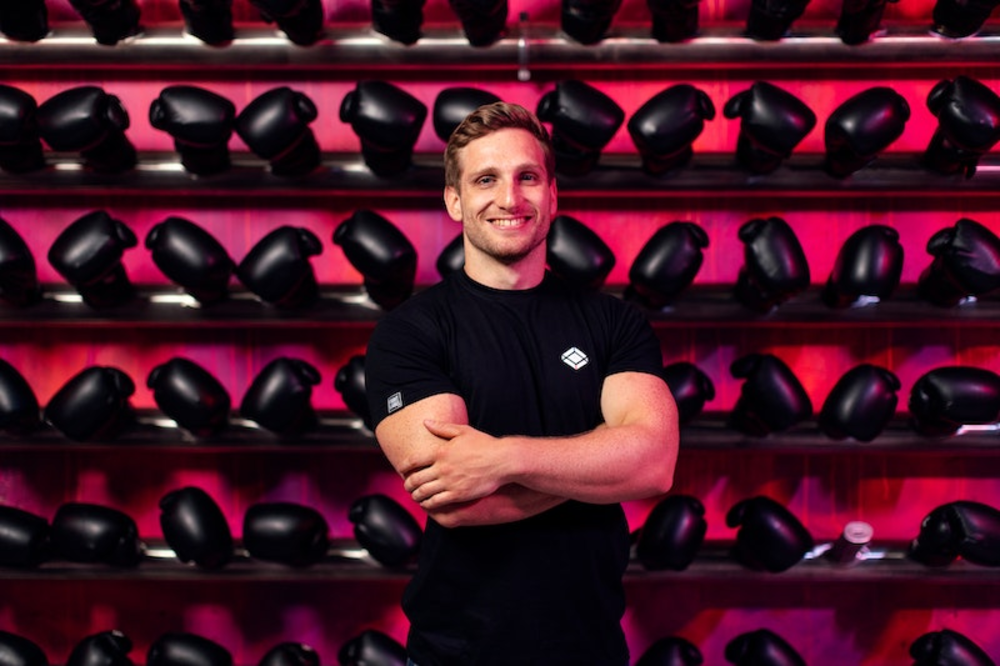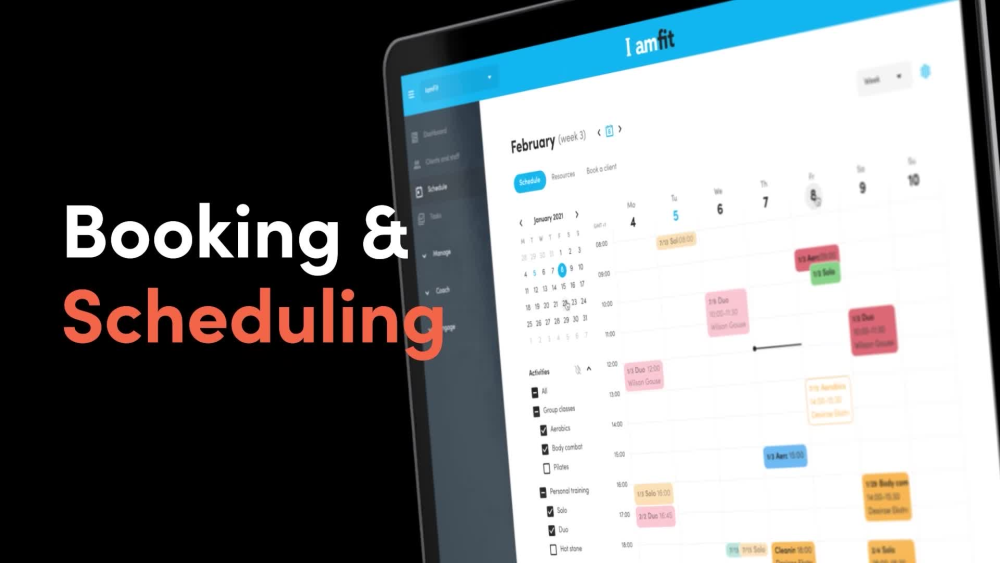Opening your very own gym or fitness center can be an exhilarating journey. Here is an outline of how to open a fitness studio.
Whether you’re passionate about high-intensity interval training, yoga, or group exercise classes, the path to owning a successful fitness business is filled with meticulous planning, decision-making, and understanding of your target audience.
Dive into this comprehensive guide to take your first steps into the world of fitness businesses.
1. Craft Your Fitness Studio Business Plan

Without a thorough business plan, you risk blending in with countless other gyms and fitness centers. Let’s break down the process of conceptualizing your fitness space and naming it.
Identify Your Passion and Expertise
What draws you into the world of fitness? Whether it’s the serenity of yoga, the intensity of high-intensity interval training, or the community vibes of group exercise classes, your passion will drive your business.
Your expertise and experience in a particular area will also give you an edge in offering specialized services.
Research the Market
Before settling on a concept, dive deep into market research. Find out what fitness services are oversaturated in your area and where the gaps are.
Maybe there’s a demand for boutique fitness studios offering personalized experiences, or perhaps your locality lacks a dedicated yoga studio.
Aligning your concept with market demand can set your fitness business up for success.
Understand Your Target Audience
Who are the people you want to serve? Are they young professionals looking for quick, high-intensity workouts, or maybe they’re seniors seeking gentle movement and community?
Understanding your target audience’s needs, preferences, and habits can greatly influence your fitness studio’s offerings and ambiance.
Service Offerings
This is the heart of what you provide. Lay out the range of services and experiences members can expect. Highlight exclusive classes, training methods, or facilities you’re offering.
Maybe it’s a specialized yoga studio space, cutting-edge gym equipment, or unique wellness workshops. Give potential members reasons to choose you over competitors.
Financial Projections
Go beyond just numbers in this section. Provide context around your financial figures, offering insight into anticipated startup costs, expected monthly revenue, and operational expenses.
Highlight any strategies you have in place to maintain profitability, whether it’s through memberships, class packages, or auxiliary services.
Management and Operations
Shed light on the backbone of your studio. Describe the organizational hierarchy, touching upon key roles, responsibilities, and the experience they bring to the table.
Also, provide a glimpse into the day-to-day logistics: how you’ll manage schedules, maintain equipment, and ensure a seamless member experience.
Crafting a robust business plan is about balancing detail with clarity. By focusing on these pillars, you lay a strong foundation for your fitness studio’s future success.
2. Decide on a Name

Your fitness studio’s name is often the first impression people get of your brand. It should resonate with the studio’s concept and evoke the emotions and experiences you want to associate with your brand.
- Reflect Your Offering: A name like “Serenity Yoga Haven” immediately conveys the calm and peaceful vibe of the studio.
- Keep it Simple: Avoid overly complex or hard-to-pronounce names. They should be easy to remember and share.
- Be Original: Do a thorough search to ensure your chosen name isn’t already in use. An original name will help in building a distinct brand identity.
- Elicit Emotion: Names that evoke emotion can be powerful. For example, “EmpowerFit” not only conveys fitness but also a sense of empowerment and strength.
If you need some inspiration to get started, check out our detailed guide on how to choose a gym name.
3. Define Your Mission and Vision

Before the first piece of gym equipment is set or the inaugural class is scheduled, it’s essential to establish a clear mission and vision for your fitness studio.
These serve as your guiding principles, dictating your studio’s direction, culture, and core values.
Your mission is your day-to-day operational ‘why.’ It answers questions such as:
- Why does your fitness studio exist?
- What do you hope to achieve in the immediate future?
- How do you intend to serve your members on a daily basis?
For example, a mission could be: “To provide our community with a welcoming fitness environment, promoting holistic health through diverse classes and expert guidance.”
Your vision, on the other hand, is the long-term goal. It’s the aspiration, the larger picture of where you envision your studio in the future. Consider:
- Where do you see your fitness studio in the next 5 or 10 years?
- How will it grow, evolve, and impact its members and the broader community?
A vision might state: “To be the leading fitness hub in the region, pioneering wellness innovations, and fostering a community bound by the shared pursuit of health.”
Your mission and vision are more than just statements on a wall or a website. They’re the heart and soul of your fitness business.
They guide decision-making, inspire staff, and give your members a deeper connection to the studio beyond just the physical space.
If you need help with this, feel free to read our guide on crafting mission statements for gyms.
4. Find Your Ideal Fitness Studio Location

Location is the stage where your fitness vision comes to life. It’s like finding the perfect backdrop for a masterpiece painting.
Situating in a bustling city center might flood your studio with urbanites seeking a quick workout escape. On the flip side, a serene suburb could attract families and individuals who favor a community-driven approach to fitness.
Accessibility is key. Think about your members’ journey. How will they get to you? Is there ample parking? Are there public transport links nearby? Your studio should be a beacon, easy to find and harder to ignore.
Remember, surroundings matter. A cafe-laden street might mean post-workout coffee dates for your members, enhancing their overall experience.
Proximity to offices could pull in the 9-to-5 crowd for quick lunch workouts or unwind sessions after a hard day’s work.
Lastly, let’s talk about ambiance. The neighborhood’s vibe will seep into your studio’s walls. A trendy, vibrant area might lend a youthful, energetic feel, whereas a location near parks and nature can infuse a calm, holistic atmosphere.
5. Obtain All the Licenses You Need

Think of these licenses as the seal of approval from various governing bodies. They not only ensure your studio meets set standards, but they also instill trust in your clients, assuring them that they’re walking into a legitimate, compliant establishment.
Business Licenses: This is your golden ticket to operate legally within your city or state. Obtaining a business license is akin to being given the green light to start your venture. It legitimizes your business, ensures you meet local business standards, and often, is a precursor to obtaining other specialized licenses.
Building and Use Permit: Imagine having the perfect studio layout in mind, only to find out that the location you’ve chosen isn’t zoned for your type of business. That’s where the building and use permit comes in. It ensures that your chosen location complies with local zoning laws, and it allows you to make certain modifications to the space if needed. This permit is especially crucial if you’re considering things like constructing locker rooms or installing heavy gym equipment.
Health and Safety Licensing: Your fitness studio is a space where people come to improve their health. The irony would be if it isn’t a safe space itself. Health and safety licenses ensure that your studio meets hygiene standards, fire safety regulations, and other criteria that keep your patrons safe. Regular inspections can occur, so maintaining these standards isn’t just for the licensing phase but for the entire duration of your business.
Music Licenses: Nothing gets the heart pumping like a great workout track. But playing music, especially in a commercial setting, isn’t as simple as pressing ‘play’. To use music during workouts without infringing on copyright laws, you’ll need to obtain the proper music licenses. This ensures that artists get their due royalties, and you can curate the perfect playlist to energize those fitness sessions without any legal hitches.
While the world of licensing might seem overwhelming at first, each license you obtain is a step toward building a trustworthy, reputable fitness studio. It’s about ensuring that every beat of the music, every piece of equipment, and every square foot of your studio resonates with professionalism and commitment to training clients in a safe environment.
6. Obtain All the Insurances You Need

The nuances of the fitness industry come with their unique set of potential risks. Whether it’s an unfortunate accident during a workout session or equipment damage, gyms have their vulnerabilities. Although not all insurance types are legally required, gym owners would have to be proactive in determining which coverage fits best.
To ensure your fitness studio is well-covered, here are some insurance types tailored for the fitness realm:
- Disability Insurance
- Business Liability Insurance
- Professional Liability Insurance
- General Liability Insurance
- Legal Protection Insurance
- Insurance for Equipment and Inventory
- Stock Coverage
- Health Coverage
- Provisions for Retirement: Pension Insurance
Taking the time to equip your fitness studio with comprehensive insurance isn’t just about avoiding potential financial pitfalls; it’s about building a robust, reliable, and resilient fitness business.
7. Design Your Gym Layout

The design and layout play a pivotal role in how members experience the space and interact with it. Here’s how to approach this crucial aspect:
- Flow: Like a well-choreographed dance, your gym should allow for smooth transitions between different areas. Consider the natural path a member might take, from the entrance to locker rooms to cardio areas, strength training zones, and specialized spaces like yoga rooms.
- Cardio Zone: Position treadmills, ellipticals, and stationary bikes in a manner that provides enough personal space for users, yet maximizes the number of machines you can fit.
- Strength Training: Allocate space for free weights, ensuring there’s ample room for safe usage. Machines should be organized by muscle group for easy navigation.
- Group Exercise Area: A separate space, ideally with a mirrored wall, for group classes can enhance the communal experience. Ensure there’s enough room for everyone to move freely.
- Visibility: Natural lighting can be a massive booster of mood and energy. Whenever possible, ensure that areas, especially cardio zones, benefit from external windows. For spaces without natural light, consider ambient lighting that’s neither too dim nor overwhelmingly bright.
- Flexibility: The world of fitness is ever-evolving. Design your space to be adaptable. Today’s high-intensity interval training zone could be tomorrow’s VR workout area.
- Amenities Positioning: Locker rooms should be easily accessible but discreet. Similarly, water stations should be strategically placed for quick hydration breaks without disrupting the flow of the workout areas.
- Safety: Ensure clear pathways, no tripping hazards, and easily accessible emergency exits. This not only keeps members safe but also provides peace of mind.
When you’re designing your gym layout, you’re creating an experience. It’s where functionality meets inspiration. By considering both the practical and the motivational aspects, you set the stage for a space that’s inviting, energizing, and efficient.
8. Invest in Quality Fitness Studio Equipment

Quality fitness equipment is the backbone of any reputable fitness studio. It not only ensures your members have the best experience but also reflects the standards and values of your establishment.
Let’s say a member is eager to try out high-intensity interval training, only to find the treadmill malfunctioning. Or, a yoga enthusiast unable to deepen their practice because of a worn-out mat.
As a fitness business owner, you must prioritize top-notch equipment, from resistance bands to state-of-the-art weight machines, creating an environment where members can confidently pursue their fitness goals, trust in your brand, and regularly return, knowing they’re getting value for their membership.
9. Hire Experienced Personal Trainers

When members walk into a fitness studio, they’re not just seeking equipment; they’re seeking guidance, expertise, and motivation. This is where personal trainers become the heartbeat of your establishment. Here is why hiring personal trainers is a game-changer for your fitness business:
- Expertise Matters: Fitness isn’t a one-size-fits-all journey. Experienced personal trainers come with a wealth of knowledge about exercise physiology, nutrition, and program design. Their depth of understanding ensures that members receive advice and routines tailored to their individual needs.
- Safety First: An essential part of fitness is ensuring exercises are done correctly to prevent injury. Seasoned trainers can quickly identify incorrect postures or techniques, making necessary corrections on the spot. Their vigilance ensures that members exercise safely and effectively.
- Building Trust: A personal trainer often becomes a member’s confidant, motivator, and even therapist. Experienced trainers understand the importance of building a trusting relationship, ensuring that members feel heard, understood, and supported.
- Results-Driven: One of the main reasons people flock to fitness studios is to see results. Whether it’s weight loss, muscle gain, or improving athletic performance, experienced trainers have the know-how to set achievable goals and chart out effective strategies to reach them.
- Boosting Retention and Referrals: Satisfaction breeds loyalty. When members see tangible results and feel supported, they’re more likely to stick around. Moreover, they become ambassadors for your studio, spreading the word about the exceptional training they receive.
- Professionalism: Experienced trainers uphold a level of professionalism that enhances your studio’s reputation. From punctuality to attire, from communication skills to conflict resolution, their seasoned approach adds immense value.
By investing in top-tier trainers, you’re not just hiring employees; you’re curating an experience, setting the stage for success, and ensuring your members embark on a transformative fitness journey.
10. Determine Your Pricing Strategy

Setting the right price for your fitness studio’s offerings is a delicate balance between ensuring profitability and providing value to your members. Here’s a closer look at crafting an effective pricing strategy:
- Competitive Analysis: Begin by scoping out your competition. What are similar fitness studios or gyms in your area charging? This gives you a ballpark range to work within and helps you identify any gaps in the market.
- Value Proposition: What makes your studio unique? If you offer specialized classes, state-of-the-art equipment, or expert trainers that others don’t, you might be able to command a higher price. Always align your prices with the value you deliver.
- Cost Structure: Understand your overheads, including rent, utilities, equipment maintenance, staff salaries, and marketing. Setting prices without considering costs could lead to financial pitfalls.
- Tiered Memberships: Offer a variety of membership options. From basic access to VIP packages with personal training sessions and exclusive classes, providing choices can cater to a wider audience.
- Promotions & Discounts: Early bird rates, off-peak pricing, or family memberships can attract different segments of the market. Special promotions can also be a great way to incentivize long-term commitments.
- Feedback & Flexibility: After rolling out your pricing, seek feedback. If members find immense value, they won’t mind a price point that’s slightly higher. On the flip side, if sign-ups are slow, you might need to adjust.
- Transparent Communication: Whatever your pricing strategy, be transparent. Hidden fees or sudden price hikes can damage trust. Clearly communicate any changes and the reasons behind them.
11. Choose the Right Fitness Studio Software

Selecting the right software for your fitness studio is crucial for streamlining operations and enhancing the member experience.
The ideal software such as Virtuagym’s fitness studio software can help you effortlessly handle membership management, booking, scheduling, and billing, and offer insights through analytics.
Moreover, an integrated mobile app can be a game-changer, allowing members to check class schedules, book sessions, and track their progress on the go.
By investing in a comprehensive and user-friendly software solution, you not only simplify administrative tasks but also elevate the overall experience for your clients, fostering loyalty and ensuring smooth operations.
Conclusion
Starting a boutique fitness studio is an exciting venture for those passionate about health and well-being. Remember, it’s not just about owning your fitness studio.
It’s about creating a community where people come together to better themselves.
Opening a fitness studio shares many similarities with launching a gym, such as market analysis, strategic planning, and community building. Discover the essential tips for opening a successful gym in our comprehensive guide. This resource offers valuable insights for aspiring fitness studio owners, covering everything from planning to choosing the right pricing strategy.
With proper planning, dedication, and understanding of your market, you are well on your way to start your own fitness business. Cheers to making the world a fitter place!




